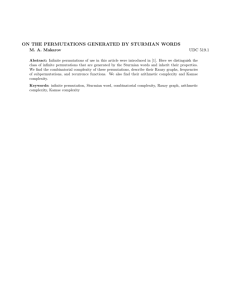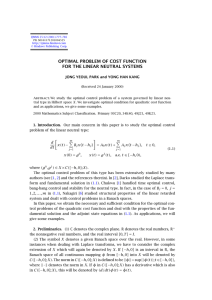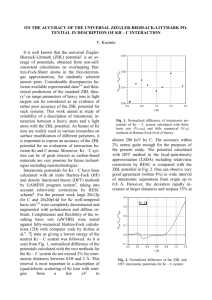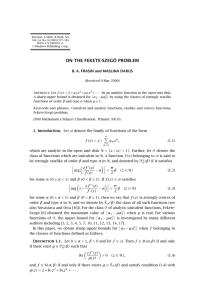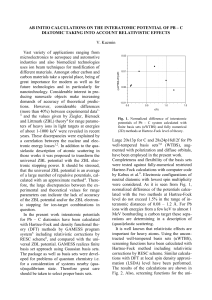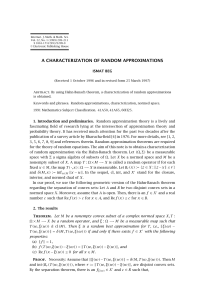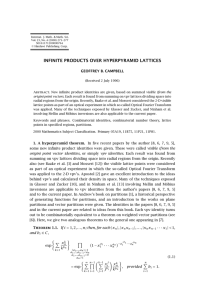BOUNDARY CONTROL PROBLEM WITH AN INFINITE NUMBER OF VARIABLES HUSSAIN A. EL-SAIFY
advertisement
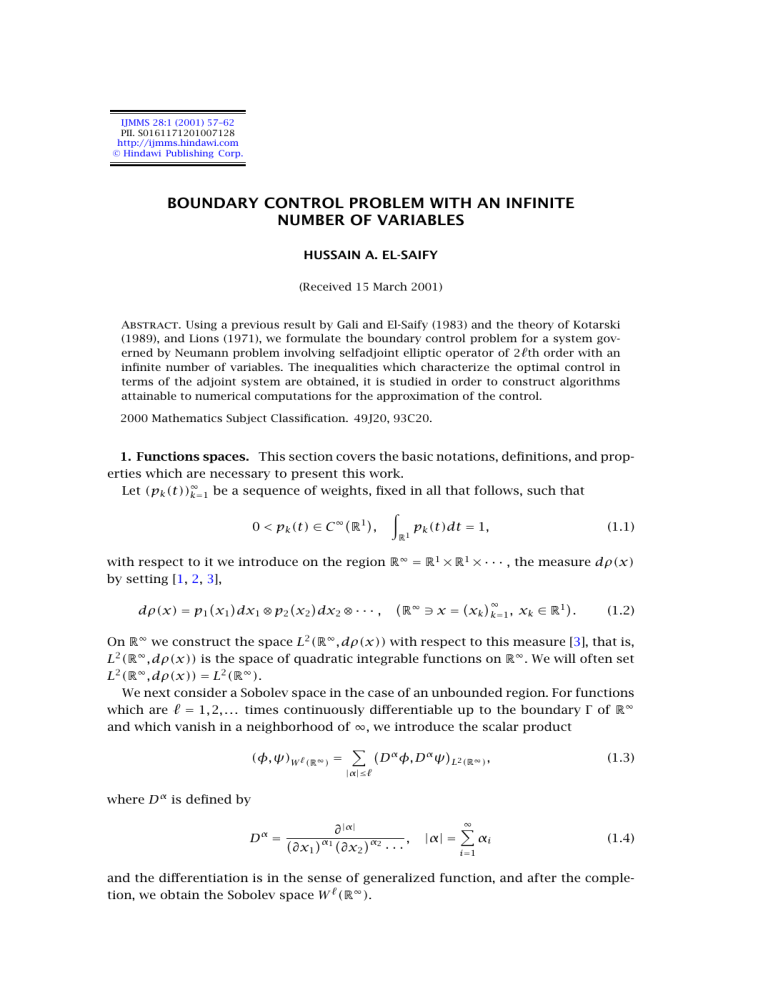
IJMMS 28:1 (2001) 57–62 PII. S0161171201007128 http://ijmms.hindawi.com © Hindawi Publishing Corp. BOUNDARY CONTROL PROBLEM WITH AN INFINITE NUMBER OF VARIABLES HUSSAIN A. EL-SAIFY (Received 15 March 2001) Abstract. Using a previous result by Gali and El-Saify (1983) and the theory of Kotarski (1989), and Lions (1971), we formulate the boundary control problem for a system governed by Neumann problem involving selfadjoint elliptic operator of 2th order with an infinite number of variables. The inequalities which characterize the optimal control in terms of the adjoint system are obtained, it is studied in order to construct algorithms attainable to numerical computations for the approximation of the control. 2000 Mathematics Subject Classification. 49J20, 93C20. 1. Functions spaces. This section covers the basic notations, definitions, and properties which are necessary to present this work. Let (pk (t))∞ k=1 be a sequence of weights, fixed in all that follows, such that 0 < pk (t) ∈ C ∞ R1 , R1 pk (t)dt = 1, (1.1) with respect to it we introduce on the region R∞ = R1 × R1 × · · · , the measure dρ(x) by setting [1, 2, 3], dρ(x) = p1 x1 dx1 ⊗ p2 x2 dx2 ⊗ · · · , ∞ ∞ R x = xk k=1 , xk ∈ R1 . (1.2) On R∞ we construct the space L2 (R∞ , dρ(x)) with respect to this measure [3], that is, L2 (R∞ , dρ(x)) is the space of quadratic integrable functions on R∞ . We will often set L2 (R∞ , dρ(x)) = L2 (R∞ ). We next consider a Sobolev space in the case of an unbounded region. For functions which are = 1, 2, . . . times continuously differentiable up to the boundary Γ of R∞ and which vanish in a neighborhood of ∞, we introduce the scalar product (φ, ψ)W (R∞ ) = D α φ, D α ψ L2 (R∞ ) , (1.3) |α|≤ where D α is defined by ∂ |α| α1 α , ∂x1 ∂x2 2 · · · Dα = |α| = ∞ αi (1.4) i=1 and the differentiation is in the sense of generalized function, and after the completion, we obtain the Sobolev space W (R∞ ). 58 HUSSAIN A. El-SAIFY As in the case of a bounded region, the spaces W (R∞ ) form a sequence of positive spaces. We can construct the negative spaces W − (R∞ ) with respect to the zero space W 0 (R∞ ) = L2 (R∞ ) and then we have the following equipped [1, 3], W R∞ ⊆ L2 R∞ = W 0 R∞ ⊆ W − R∞ , φW (R∞ ) ≥ φL2 (R∞ ) ≥ φW − (R∞ ) . (1.5) As in [7] by using the Laplace-Beltrami operator (−∆Γ ) on Γ , we choose the scalar product on the space H −β−1/2 (Γ ), fractional order Sobolev spaces, as −β−1/2 φ · ψ dΓ . (1.6) − ∆Γ (φ, ψ)H −β−1/2 (Γ ) = Γ 2. Facts and results. Let π (φ, ψ) be a continuous bilinear form which has the representation A ∈ L W R∞ , W − R∞ , π (φ, ψ) = (Aφ, ψ)L2 (R∞ ) , φ, ψ ∈ W R∞ , (2.1) where A is a bounded selfadjoint elliptic operator of 2th order with an infinite number of variables which takes the form, [2, 4, 8, 9], (Aφ)(x) = = ∂ 2α 1 (−1)|α| pk xk φ(x) + q(x)φ(x) 2α pk xk ∂xk |α|≤ k=1 ∞ ∞ |α| (−1) Dk2α φ (2.2) (x) + q(x)φ(x), |α|≤ k=1 where ∂α 1 pk xk φ(x) , Dkα φ (x) = α pk xk ∂xk (2.3) and the potential q(x) is a real-valued function from L2 (R∞ ) such that q(x) ≥ c0 > 0, c0 is a constant [5]. The above bilinear form is coercive in W (R∞ ) that means π (φ, φ) ≥ cφ2W (R∞ ) , φ ∈ W R∞ , c constant. (2.4) Since π (φ, φ) = ∞ Dkα φ, Dkα φ L2 ((R∞ )) + (qφ, φ)L2 ((R∞ )) |α|≤ k=1 ≥ φW (R∞ ) + c0 φW (R∞ ) ≥ cφW (R∞ ) , (2.5) 1 ≥ c > 0. From the coerciveness condition (2.4) and using the Lax-Milgram lemma [6, 7] we have the following lemma which define the Neumann problem for the operator A and enables us to obtain the state of our control problem. BOUNDARY CONTROL PROBLEM WITH AN INFINITE . . . 59 Lemma 2.1. If (2.4) is satisfied then there exists a unique element y ∈ W (R∞ ) satisfying Neumann problem in R∞ , Ay = f , ∂βy β ∂νA =h (2.6) on Γ , ∞ β β where ∂ β y/∂νA = |β|≤−1 k=1 (Dk y) cos(n, xk ) on Γ , cos(n, xk ) = kth direction cosine of n, n being the normal at Γ . Proof. From the coerciveness condition and using the Lax-Milgram lemma [6] there exists a unique y ∈ W (R∞ ) such that ∀ψ ∈ W R∞ π (y, ψ) = L(ψ) (2.7) which is known as the variational Neumann problem where L(ψ) is a continuous linear form on W (R∞ ) and take the form L(ψ) = f ψ dρ(x) + hψ dΓ , f ∈ L2 R∞ , h ∈ H −β−1/2 (Γ ). (2.8) R∞ Γ Equation (2.7) is equivalent to on R∞ , Ay = f (2.9) multiplying both sides by ψ and applying Green’s formula, we have (Ay)dρ(x) = f ψ dρ(x), R∞ ∞ R∞ (−1)|α| Dk2α y ψ dρ(x) + |α|≤ k=1 ∞ R∞ Dkα y Dkα ψ R∞ R∞ dρ(x) − |α|≤ k=1 Γ + q · yψ dρ(x) = ∞ f ψ dρ(x), ψ Dkα y cos n, xk dΓ |β|≤−1 k=1 R∞ R∞ (2.10) q · yψ dρ(x) = R∞ φψ dρ(x). Then π (y, ψ) − Γ ∞ β ψ Dk y cos n, xk dΓ = |β|≤−1 k=1 R∞ f ψ dρ(x), (2.11) since π (y, ψ) = L(ψ) we have Γ h− ∂βy β ∂νA ψ dΓ = 0, (2.12) so h= ∂βy β ∂νA on Γ . (2.13) 60 HUSSAIN A. El-SAIFY 3. Boundary control problem. The space U = H −β−1/2 (Γ ) is the space of controls. For every control u ∈ U , Bu ∈ W − (R∞ ) is given by (3.1) (Bu, ψ) = uψ dΓ , ψ ∈ W R∞ . Γ The state y(u) ∈ W (R∞ ) of the system is given by the solution of π y(u), ψ = L(ψ) + (Bu, ψ) ∀ψ ∈ W R∞ (3.2) which may be interpreted as Lemma 2.1 to Ay(u) = f ∂ β y(u) β ∂νA in R∞ , = h+u on Γ . (3.3) The observation z(u) = y(u) and the cost function J(v) is given by 2 J(v) = y(v) − zd L2 (R∞ ) + (Nv, v)U 2 = y(v) − zd dρ(x) + (Nv, v)U , (3.4) R∞ where zd ∈ L2 (R∞ ) and N ∈ L(U , U ), N is Hermitian positive definite operator. We wish to find inf J(v), (3.5) v∈Uad where Uad (set of admissible controls) is a closed convex subset of U. Under the given consideration we have the following theorem. Theorem 3.1. Assume that (2.4) holds and the cost function being given by (3.4). The optimal control u is characterized by (3.3) and −+β+1/2 P (u)|Γ + Nu, v − u ≥ 0 ∀v ∈ Uad , (3.6) − ∆Γ U where P (u) is the adjoint state of y(u). Outline of the proof. As the proof of theorems in [4, 6], the control u ∈ Uad is optimal if and only if J (u)(v − u) ≥ 0 ∀ v ∈ Uad (3.7) which may be written as y(u) − zd , y(v) − y(u) L2 (R∞ ) + (Nu, v − u)U ≥ 0. (3.8) In order to transform (3.8), we define the adjoint state P (u) as the solution of the adjoint Neumann problem Ap(u) = y(u) − zd ∂ β P (u) β ∂νA =0 in R∞ , on Γ . (3.9) BOUNDARY CONTROL PROBLEM WITH AN INFINITE . . . 61 Now, multiplying the first equation in (3.9) by (y(v) − y(u)) and applying Green’s formula, finally taking into account the conditions in (3.3) and (3.9), we obtain y(u) − zd y(v) − y(u) dρ(x) ∞ R = Ap(u) y(v) − y(u) dρ(x) = R∞ P (u) β ∂νA Γ − = ∂ β y(v) Γ ∂β Γ β ∂νA − ∂ β y(u) β ∂νA dΓ P (u) y(v) − y(u) dΓ + (3.10) R∞ P (u)A y(v) − y(u) dρ(x) P (u)(v − u)dΓ . Hence (3.8) becomes Γ P (u)(v − u)dΓ + (Nu, v − u)U ≥ 0. (3.11) By using the definition of the scalar product in H −β−1/2 (Γ ), then (3.9) is equivalent to − ∆Γ −+β+1/2 P (u)|Γ + Nu, v − u U ≥0 which is equivalent to −β−1/2 P (u) + − ∆Γ Nu (v − u)dΓ ≥ 0 Γ ∀v ∈ Uad ∀v ∈ Uad (3.12) (3.13) which completes the proof. References [1] [2] [3] [4] [5] [6] [7] J. M. Berezansk’iı̆, Expansions in Eigenfunctions of Selfadjoint Operators, American Mathematical Society, Rhode Island, 1968. MR 36#5768. Zbl 0157.16601. , The selfadjointness of elliptic operators with an infinite number of variables, Ukraïn. Mat. Ž. 27 (1975), no. 6, 729–742. MR 53#8890. J. M. Berezanskiı̆, Samosopryazhennye Operatory V Prostranstvakh Funktsii Beskonechnogo Chisla Peremennykh [Selfadjoint operators in spaces of functions of an infinite number of variables], Naukova Dumka, Kiev, 1978 (Russian). MR 81b:47035. Zbl 449.47001. I. M. Gali and H. A. El-Saify, Distributed control of a system governed by Dirichlet and Neumann problems for a selfadjoint elliptic operator with an infinite number of variables, J. Optim. Theory Appl. 39 (1983), no. 2, 293–298. MR 84f:49033. Zbl 502.49013. , Optimal control of systems governed by Petrowsky type equation with an infinite number of variables, J. Inform. Optim. Sci. 4 (1983), no. 1, 83–94. MR 84f:49032. Zbl 535.49017. W. Kotarski, Optimal control of a system governed by a parabolic equation with an infinite number of variables, J. Optim. Theory Appl. 60 (1989), no. 1, 33–41. MR 90a:49024. Zbl 632.49013. J.-L. Lions, Optimal Control of Systems Governed by Partial Differential Equations, Die Grundlehren der mathematischen Wissenschaften, vol. 170, Springer-Verlag, New York, 1971. MR 42#6395. 62 [8] [9] HUSSAIN A. El-SAIFY J.-L. Lions and E. Magenes, Non-Homogeneous Boundary Value Problems and Applications. Vol. I, Die Grundlehren der mathematischen Wissenschaften, vol. 181, SpringerVerlag, New York, 1972. MR 50#2670. Zbl 223.35039. , Non-Homogeneous Boundary Value Problems and Applications. Vol. II, Die Grundlehren der mathematischen Wissenschaften, vol. 182, Springer-Verlag, New York, 1972. MR 50#2671. Zbl 227.35001. Hussain A. El-Saify: Mathematics Department, Faculty of Science, Branch of Cairo University, Beni Suef, Egypt E-mail address: elsaify− ah@hotmail.com

